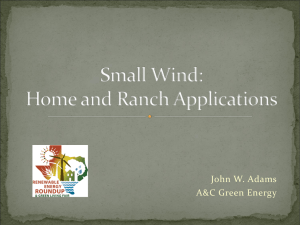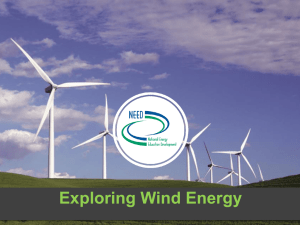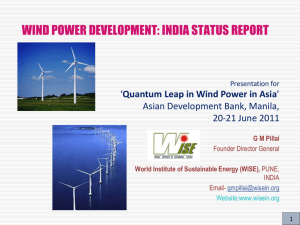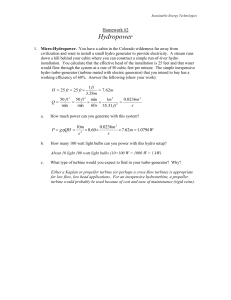Homework Solutions - faculty at Chemeketa
advertisement
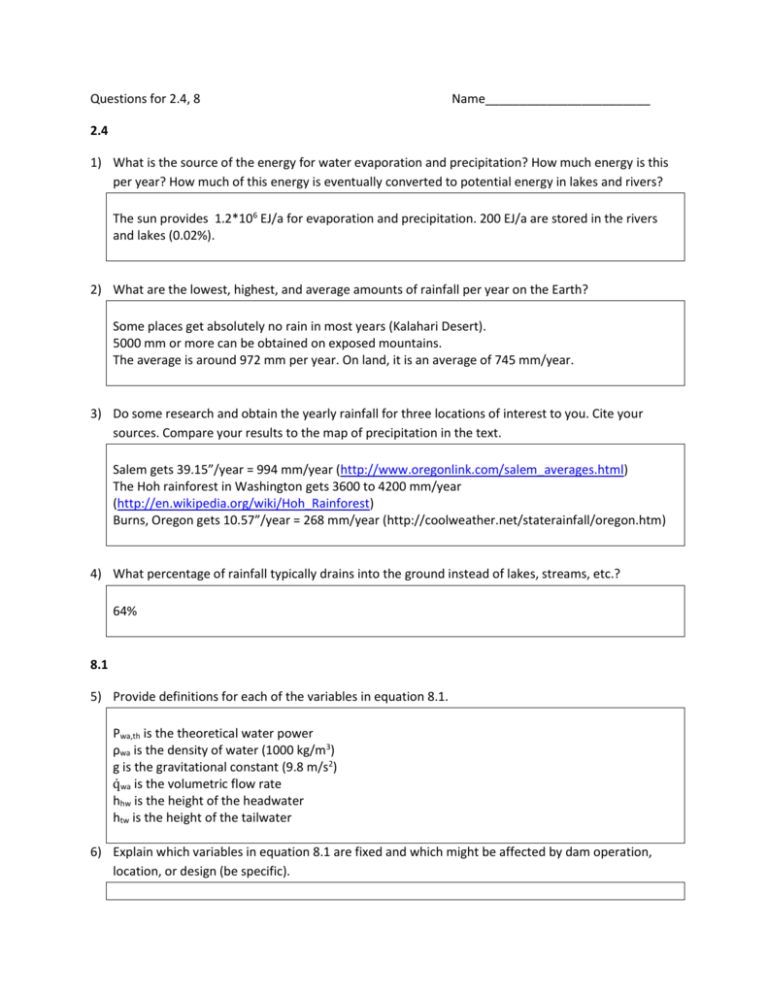
Questions for 2.4, 8 Name________________________ 2.4 1) What is the source of the energy for water evaporation and precipitation? How much energy is this per year? How much of this energy is eventually converted to potential energy in lakes and rivers? The sun provides 1.2*106 EJ/a for evaporation and precipitation. 200 EJ/a are stored in the rivers and lakes (0.02%). 2) What are the lowest, highest, and average amounts of rainfall per year on the Earth? Some places get absolutely no rain in most years (Kalahari Desert). 5000 mm or more can be obtained on exposed mountains. The average is around 972 mm per year. On land, it is an average of 745 mm/year. 3) Do some research and obtain the yearly rainfall for three locations of interest to you. Cite your sources. Compare your results to the map of precipitation in the text. Salem gets 39.15”/year = 994 mm/year (http://www.oregonlink.com/salem_averages.html) The Hoh rainforest in Washington gets 3600 to 4200 mm/year (http://en.wikipedia.org/wiki/Hoh_Rainforest) Burns, Oregon gets 10.57”/year = 268 mm/year (http://coolweather.net/staterainfall/oregon.htm) 4) What percentage of rainfall typically drains into the ground instead of lakes, streams, etc.? 64% 8.1 5) Provide definitions for each of the variables in equation 8.1. Pwa,th is the theoretical water power ρwa is the density of water (1000 kg/m3) g is the gravitational constant (9.8 m/s2) q̇ wa is the volumetric flow rate hhw is the height of the headwater htw is the height of the tailwater 6) Explain which variables in equation 8.1 are fixed and which might be affected by dam operation, location, or design (be specific). The density of water cannot be manipulated. The gravitational constant cannot be manipulated much (it varies a bit from place to place). The volumetric flow rate can be manipulated in the short term, but not the long term (this will be determined by the rainfall upstream) The height difference can be manipulated by the height of the dam. Location and design choices will be key. 7) Use equation 8.1 and your research from question 3 to calculate the theoretical power of rainfall incident on a flat roof of height 4 m and area 100 m2. In other words, imagine connecting 100% efficient generators to each of the downspouts. Compare this to 1 kW, the electrical power demand of an average residential home in the United States. Pwa,th = ρwagq̇ wa(hhw – htw) The volume of water in a year will be the area times the depth (using Salem data), (100 m2)(0.994 m) = 99.4 m3. The volume flow rate is this volume divided by the time, which is one year (31,600,000 s). q̇ wa = 99.4 m3/31,600,000 s = 3.14*10-6 m3/s. Pwa,th = (1000 kg/m3)(9.8 m/s2)(3.14*10-6 m3/s)(4) = 0.123 W. The average residential home use of 1 kW is about 8000 times this value. This idea is pretty useless. 8) Provide definitions for each of the additional variables (compared to equation 8.1) in equation 8.7 for actual usable water power. Note that there is a typo as the qwa term should have a dot above it. ξIS = loss correction value for the intake structure vwa,2 = speed of water at the pressure head ξPS= loss coefficient of the penstock vwa,3 = speed of water at entry to turbine vwa,5 = speed of water at exit 9) Explain which additional variables in equation 8.7 are fixed and which might be affected by dam operation, location, or design (be specific). The ξ can be affected by design The v can be affected by design and operation 8.2 10) Describe the difference between “run-of river” and “storage” power stations. Run-of-river power stations do not have reservoirs while storage power stations do. 11) Provide definitions of low-head, medium-head, and high-head power stations. Low head is by definition up to 20 m. Medium head is by definition 20 to 100 m. High head is by definition 100 to 2000 m. 12) Provide definitions of reaction and impulse turbines. Reaction turbines use pressure to rotate the turbine blades. Impulse turbines create a fast stream of water (kinetic energy) to rotate the turbine blades. 13) The difference in height between the reservoir and the outflow for a dam is 200 m. The flow rate varies significantly between 1.0 and 5.0 m3/s due to significant variations in rainfall and power demand. Specify the best choice of a single turbine (Pelton, Francis, Kaplan, etc.) and explain why you would make that choice. What would be the range of theoretical water power? Figure 8.8 indicates that either a Francis or Pelton turbine would be appropriate. This is because the other types of turbines cannot handle this much power. Figure 8.9 indicates that a Pelton turbine would be better because it is highly efficient across the large range of flow rates. The power would be roughly 1.8 MW to 8 MW according to the graph. Equation 8.1 could also be used. 14) The flow rate of a river is a very consistent 200 m3/s. It is desired that the dam produce 500 MW of power. How high should the dam be built? Specify the best choice of a single turbine (Pelton, Francis, Kaplan, etc.) and explain why you would make that choice. The height should be at least 300 m, according to figure 8.8. The Francis turbine is the only one that can generate this much power. 15) A farmer would like your help in harnessing hydropower from steep section of a creek on his property. The creek has a flow rate of up to 0.050 m3/s and has a drop of 2.0 m. How much power can be obtained theoretically? Specify the best choice of a single turbine (Pelton, Francis, Kaplan, etc.) and explain why you would make that choice. What is the efficiency of this turbine? Equation 8.1 can be used to calculate the theoretical power: P = ρwagq̇ wa(hhw – htw) = (1000)(9.8)(0.050)(2) = 980 W The text suggests water wheels for small power stations such as this due to cost. The efficiency can be up to 70% or 80%. 8.3 16) Describe the various significant expenses in building and using hydroelectric power. Construction of structural works is 40 to 50% Mechanical components are 20 to 25% Electrical installations are 5 to 10% Ecological compensation measures can be 10 to 20% 17) What are the electricity generation costs in $/kWh for each of the four example hydroelectric power stations. Using 1 € = $1.45, each of the costs in table 8.2 can be converted. Cost I = 0.065 €/kWh * ($1.33/€) = 0.086 $/kWh Cost II = 0.073 €/kWh * ($1.33/€) = 0.097 $/kWh Cost III = 0.049 €/kWh * ($1.33/€) = 0.065 $/kWh Cost IV = 0.058 €/kWh * ($1.33/€) = 0.077 $/kWh 18) Describe some of the environmental problems created by construction, normal function, and malfunction of hydroelectric power stations. Construction problems: Construction materials and dirt can get into the stream. Oil can be released. Normal function problems: Accumulation of sediment in reservoir, loss of sediment downstream, prevention of aquatic species migration, trauma of migratory species, reduction of water quality, loss of habitat Normal function benefits: water sports, irrigation, flood protection, and storage of drinking water Malfunction problems: release of oil or other pollutants, catastrophic floods

